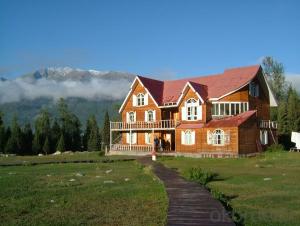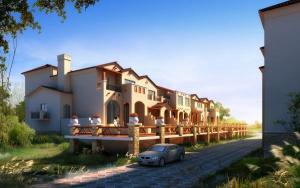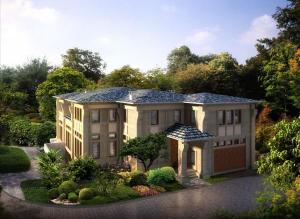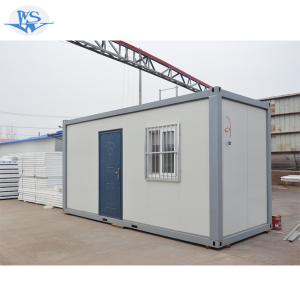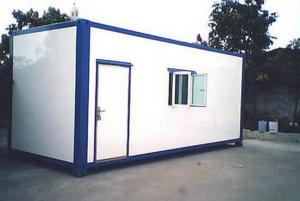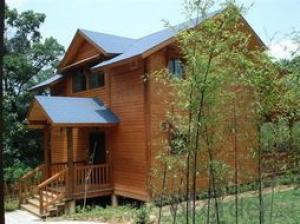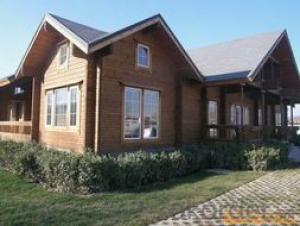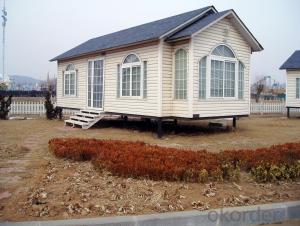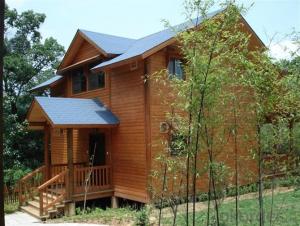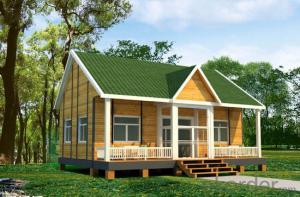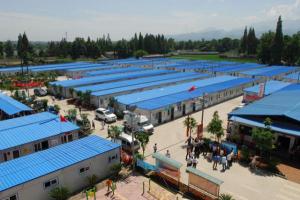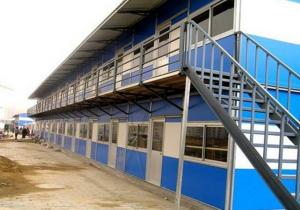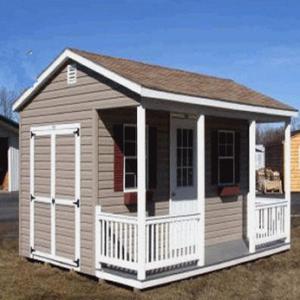villa wooden house
- Loading Port:
- China Main Port
- Payment Terms:
- TT OR LC
- Min Order Qty:
- -
- Supply Capability:
- -
OKorder Service Pledge
OKorder Financial Service
You Might Also Like
wooden villa house
New Designed Two-story Prefabricated Living Wooden House Maison Bois
1). Material: pine
2). Wall thickness: 70mm
3). Size: (7.8+0.9)x10xH6.3m
Can be made according to customers' design or plans
No pollution during the construction because of using no-toxic green material
High degree of stiffness and light weight
Concrete foundation
Earthquake and wind resistance
Natural living environment can bring happy and healthy life to you!
if you are interested in this model, please feel free to contact me, more details will be sent to you.
- Q: Are container houses eligible for financing?
- Yes, container houses are eligible for financing. Many financial institutions offer loans or mortgages specifically designed for purchasing and building container homes. However, eligibility criteria and terms may vary depending on the lender and the specific project.
- Q: Are container houses insulated for soundproofing?
- Yes, container houses can be insulated for soundproofing. Insulation materials such as foam, fiberglass, or acoustic panels can be used to reduce sound transmission and create a quieter living environment inside the container house.
- Q: Can container houses be designed to have a traditional bedroom layout?
- Yes, container houses can be designed to have a traditional bedroom layout. By utilizing creative interior design techniques and maximizing the available space, container houses can incorporate all the essential elements of a traditional bedroom, including a bed, nightstands, dressers, and even a closet. Although container houses may have limitations in terms of size and shape, with proper planning and design, it is possible to create a comfortable and functional traditional bedroom layout within a container house.
- Q: How does a senior apartment be defined?
- In other words, for residential, divided into ordinary standard residential, ordinary residential, apartments and villas
- Q: Can container houses be designed to blend with the surrounding environment?
- Yes, container houses can be designed to blend with the surrounding environment. With proper planning and design, container houses can be customized to harmonize with the natural landscape or complement the existing architectural style of the area. Here are a few ways container houses can be designed to blend seamlessly with their surroundings: 1. Material selection: Opting for natural and sustainable materials, such as wood or stone finishes, can help the container house blend with the natural environment. These materials can be used for cladding or as accents to soften the industrial look of the containers. 2. Color palette: Choosing earthy tones, muted colors, or shades that match the surroundings can make the container house visually blend into the environment. This can be achieved through painting, using natural pigments, or employing camouflage techniques like incorporating plants or green roofs. 3. Landscape integration: Incorporating landscaping elements around the container house can enhance its integration with the surroundings. This can include planting trees, shrubs, or creating gardens that complement the natural features of the area. 4. Design adaptation: Modifying the container house's design to mimic the local architectural style can help it blend better with the surrounding environment. This could involve adding traditional elements, such as pitched roofs, porches, or balconies, to create a harmonious integration with nearby structures. 5. Orientation and placement: Properly positioning the container house on the site can maximize its relationship with the surrounding environment. Orienting windows and openings to capture scenic views or natural sunlight can create a stronger connection between the house and its surroundings. Ultimately, the design possibilities for container houses are endless, and with thoughtful planning, they can be tailored to blend seamlessly with their surroundings. By utilizing appropriate materials, colors, landscaping, and design adaptations, container houses can become an integral part of any environment while still maintaining their unique and sustainable character.
- Q: How long do container houses last?
- Container houses can last for several decades, typically around 25 to 30 years, depending on various factors such as maintenance, climate conditions, and the quality of construction materials used.
- Q: Can container houses be stacked on top of each other?
- Indeed, container houses have the capability to be stacked atop one another. The modular design of container houses is a key advantage, facilitating their effortless stacking and amalgamation into multi-story edifices. Shipping containers' consistent shape and size make them an ideal choice for stacking, as they can be firmly connected and reinforced to guarantee structural integrity. The stacking of container houses also offers supplementary space and adaptability, rendering them a favored option for various applications like apartment buildings, hotels, and even office complexes. However, it is vital to emphasize that the implementation of appropriate engineering and construction techniques is imperative to ensure the safety and stability of stacked container houses.
- Q: Are container houses pet-friendly?
- Certainly, container houses have the potential to be suitable for pets. Numerous container houses can be tailored to cater to pets, incorporating elements like doggy doors, integrated pet beds, and specific pet-friendly zones. Furthermore, container houses frequently boast spacious layouts, granting pets ample room to roam and engage in play. By meticulously devising and designing, container houses can establish a cozy and secure setting for homeowners and their beloved pets alike.
- Q: Can container houses be designed with a modern or contemporary aesthetic?
- Certainly, container houses can be designed with a modern or contemporary aesthetic without a doubt. In fact, numerous architects and designers have eagerly embraced the utilization of shipping containers as a sustainable and cost-effective building material, while also incorporating sleek and trendy designs. One of the advantages of utilizing container houses for modern or contemporary designs lies in their clean and industrial appearance. The containers' metal structure, characterized by straight lines and geometric shapes, lends itself well to a modern aesthetic. Moreover, the containers' uniformity allows for modular design, which can be easily customized to create a contemporary look. Designers often integrate large windows, open floor plans, and minimalist interiors to enhance the modern atmosphere of container houses. This not only allows for ample natural light and an airy ambiance but also ensures a seamless integration between indoor and outdoor spaces. Furthermore, the use of high-quality finishes, such as wood or polished concrete, can further enhance the overall contemporary aesthetic of the container house. Furthermore, container houses can be creatively stacked or arranged to create unique and visually captivating designs. Architects have experimented with cantilevered sections, rooftop gardens, and even multi-story container structures, all of which contribute to a modern and cutting-edge appearance. Ultimately, container houses present a versatile canvas for modern or contemporary designs. With the right architectural vision and meticulous attention to detail, these structures can be transformed into stylish and visually appealing homes that flawlessly blend sustainability and aesthetics.
- Q: What sizes do container houses come in?
- Container houses come in a variety of sizes to cater to different needs and preferences. The most common sizes for container houses are 20 feet and 40 feet in length. A 20-foot container house typically provides around 160 square feet of living space, while a 40-foot container house can offer around 320 square feet. However, container houses can also be custom-built to suit specific requirements. It is possible to combine multiple containers to create larger living spaces or stack them vertically to create multi-story homes. Some container houses even feature additional extensions or modules to increase the overall living area. Ultimately, the size of a container house depends on individual needs, available space, and budget constraints. Whether you are looking for a compact and minimalist living space or a more spacious and luxurious container home, there are various size options available to accommodate different lifestyles and design preferences.
Send your message to us
villa wooden house
- Loading Port:
- China Main Port
- Payment Terms:
- TT OR LC
- Min Order Qty:
- -
- Supply Capability:
- -
OKorder Service Pledge
OKorder Financial Service
Similar products
Hot products
Hot Searches
Related keywords
